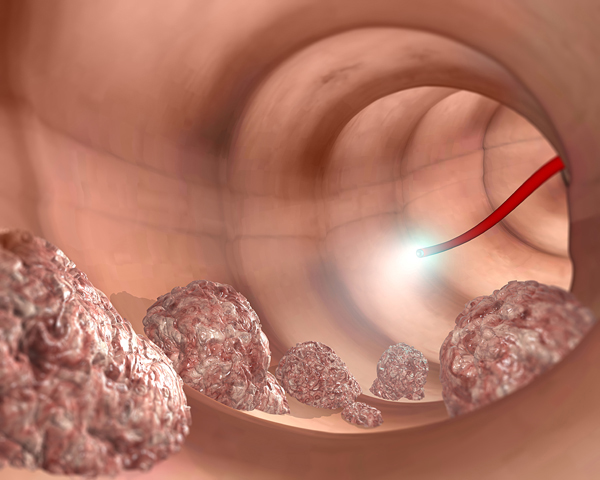Massachusetts Institute of Technology (MIT) researchers have developed a triple combination patch using chemotherapy, gene therapy and light-based therapy to destroy colorectal cancer tumors. The results of this research – published in the journal, Nature Materials – describe how the multi-action patch could be applied to the tumor site before or after surgical removal of the growth.
Many colorectal cancers start out as a small growth of abnormal cells, known as a polyp, which have the potential to grow over the course of 10 to 15 years. Though not all polyps are malignant, routine screening using colonoscopy can help patients maintain good colon health.
Treatment for colorectal cancer is often stage-dependent, however chemotherapy, radiation therapy and surgery are all common options. Unfortunately, surgical removal of colorectal tumors does not always result in complete elimination of all abnormal cells; 50 percent of colorectal cancers recur.
To further complicate matters, current colorectal cancer therapies are not targeted specifically to the site of the tumor, resulting in death of healthy cells and other side effects. Chemotherapy drugs in particular often have systemic effects, with only 0.7 percent of the drug reaching the site of the malignancy.
According to Natalie Artzi, a research scientist at Massachusetts Institute of Technology’s (MIT) Institute for Medical Engineering and Science (IMES), the patch could boost each therapies’ effectiveness by delivering the treatments directly to the tumor site. “This means that we are treating both the source of the cancer – the tumor – and the metastases resulting from that source, in a suboptimal manner,” Artzi continued. “That is what prompted us to think a little bit differently, to look at how we can leverage advancements in materials science, and in particular nanotechnology, to treat the primary tumor in a local and sustained manner.”
The hydrogel patch developed by Artzi and her colleagues is designed to destroy any residual cancer cells at the site of the excised tumor to help mitigate the risk of cancer recurrence and metastasis. The patch is composed of three therapeutics: gold nanorods, a chemotherapy drug and gold nanospheres.
The gold nanorods are activated in response to near-infrared radiation, which causes them to heat up and destroy the tissue surrounding the tumor site. This response also induces the local release of a chemotherapy drug. Finally, the gold nanospheres – which resist thermal activation – deliver RNA gene therapy to the tumor cells, which silences an oncogene involved in colorectal cancer tumorigenesis.
When the patch was tested in mice following surgery, the animals showed complete remission from the cancer. While the patch could be applied to the tumor before surgery to shrink the growth, Artzi and her team think it might be most effective at removing leftover cancer cells after the growth has been removed.
“This administration modality would enable, at least in early stage cancer patients, the avoidance of open field surgery and colon resection,” said Artzi. “Local application of the triple therapy could thus improve patients’ quality of life and therapeutic outcome.”












Join or login to leave a comment
JOIN LOGIN